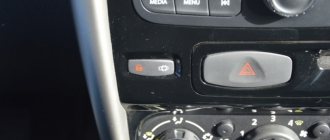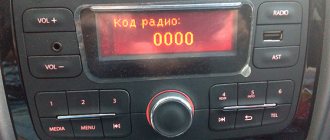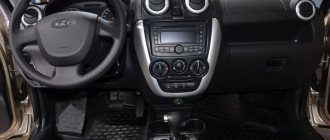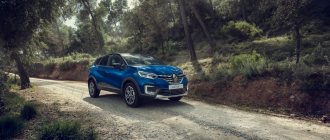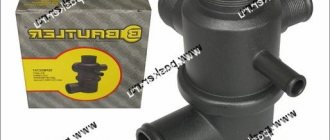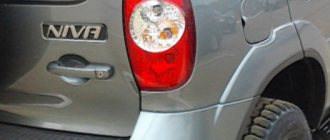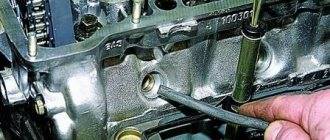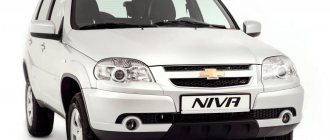Many people, when choosing a budget all-wheel drive car, often think about what to buy: Renault Duster or Niva Chevrolet? These cars are relatively inexpensive and have similar sizes, features and prices. It is for this reason that the choice is not at all easy. Today we’ll look at both cars in more detail and decide for sure which is better: Niva-Chevrolet or Renault-Duster?
It should be noted that there are plenty of fans of both models. These are the cars that are extremely common on the roads. They can be serviced in almost every car service center, and you can always buy all the necessary used spare parts very cheaply. New components are available in almost every auto parts store.
Exterior
To find out which of these two cars is better, you need to compare them in all respects and aspects. Let's start comparing the Niva-Chevrolet and Renault-Duster with their appearance. Hand on heart, let's say that Renault Duster has a very, very controversial design. “Niva-Chevrolet” does not have much in this regard, but it wins. It must be said that both cars are not particularly impressive with their external data. But it is worth considering that the Niva-Chevrolet was developed and created a long time ago, but the Renault-Duster is a more modern car. Then it’s not clear how they managed to create it with such a faded appearance?
These are typical representatives of budget cars; you shouldn’t expect anything special from this class. Optics, body lines, bumpers, etc. – it all looks somewhat poor, dull and old-fashioned. But these cars are not chosen for their external beauty, so let’s move on.
Interior
If you compare the Niva-Chevrolet and Renault-Duster in terms of interior decoration, then the situation here is as sad as with the appearance. The finishing materials on both models are cheap. Squeaks in the interior can be present from the first revolution of a car wheel that comes off the assembly line. Sound insulation is also poor, but in this aspect the Duster wins at least a little. You can modify the sound insulation on any car yourself if you have the desire, opportunity and means.
The dashboard in none of these cars can surprise you with anything. Everything is very simple and unpretentious. Not everything is conveniently located and thought out, but this is a matter of habit. The seats are comfortable, the seats themselves are also quite decent, the same can be said about the sofas in the back row.
If we talk about the size of the interior and trunk, then the Duster is a little better in this regard, it is a little more spacious inside, this is precisely the space that is not enough in the Niva-Chevrolet to comfortably accommodate three passengers in the back seat, but, again, we repeat, that everything is known by comparison.
Salon and trunk
If we compare the interiors of Chevrolet Niva vs Renault Duster, then both do not differ in any chic that owners of, for example, sedans are accustomed to. The furnishings in them are quite spartan; both models have seats without lateral support. The difference is in the finishing and its quality.
Chevrolet Niva interior
The Niva's trim is mostly plastic, although the parts fit well and don't rattle while driving. The dashboard is simple, familiar to those who have owned other VAZ cars. But there is not enough space for rear passengers - there is nowhere for them to put their legs, the space is too cramped even for a person of average height. And the driver's seat is a bit hard, which is especially noticeable on a long trip. But the review is excellent.
The leather interior of the Renault Duster is more comfortable and noticeably superior, including in terms of convenience for rear passengers. The dashboard is more modern and looks nicer. The review is slightly worse than that of its competitor, but this is perhaps the only negative. Although the interior is more comfortable, it cannot be called spacious - a tall person will feel cramped in it, especially while driving.
Salon Renault Duster
As for the trunk, its volume in the Renault Duster is 408 liters, while in the Chevrolet Niva it is only 320 liters. At the same time, in Duster it is longer, but narrower, while in Niva it is short and very small. In this regard, the Duster wins noticeably, as it allows you to load not only more, but also put longer things, and not just a couple of square boxes.
Handling and suspension
The “French” holds the road better at high speeds, both on asphalt and on dirt roads. Both cars have a monocoque body. The Niva-Chevrolet is equipped with an center lock and low gears; the Renault-Duster does not have a low range in the box, and rear-wheel drive is engaged only when required. If we compare the cross-country ability of the Renault-Duster and the Niva-Chevrolet, then the “Frenchman” loses. But it is worth saying that both cars are SUVs.
The suspension itself is reliable on both cars. It is a little harsh due to the short wheelbase, but this is not critical, you just need to get used to it if you have previously owned a car with a long wheelbase or a more expensive class.
Renault Duster
For the clutch to operate, there needs to be at least a slight “lag” between the rear wheels and the front wheels. The most interesting thing is that there are no temperature sensors in the clutch, and it turns off “due to overheating” when the control unit, through the ABS sensors, records for some time that with full voltage on the clutch, the rear wheels do not rotate, but the front wheels rotate at a significant speed. So in most cases, electronics simply play it safe.
What to choose?
In both schemes, all drive and driveshafts rotate constantly, so there is no difference in terms of fuel consumption. A scheme with a rigid clutch lock is preferable on severe off-road conditions, since electronically controlled clutches are capable of transmitting only a limited torque, and when the clutches slip, they are prone to rapid “overheating,” albeit often virtual. Unexpected automatic engagement of the clutch while cornering can sometimes be dangerous.
From personal experience
Having owned a car with an electromagnetic clutch for connecting the rear axle, I can tell you what modes I use. In the summer, on paved roads, the 2WD mode is always on; in mud, I use its full potential and turn off the ESP dynamic stabilization system. In winter, the AUTO mode is always on. First of all, to avoid losing the studs on the front wheels. Tests show that the loss of studs is especially high when the drive wheels slip. If sharp acceleration is necessary in winter, and the surface under the wheels is of poor quality, for example, tram track tiles, then I turn on the LOCK mode. And if you need to get out of a snowdrift, use LOCK mode and turn off ESP.
I also used Niva. So, if it was necessary to start on a slippery surface, I turned on the lock, and in dense traffic jams I crawled on a lower one - this way the load on the clutch is less.
You will find more information about all-wheel drive vehicles in the selection of articles from Za Rulem magazine, “Everything about all-wheel drive: not only the advantages.”
Renault Duster
or Chevrolet Niva: choosing the best
Renault Duster
and
Chevrolet Niva
are enviably popular among car enthusiasts. This is not surprising, since the prices for these all-wheel drive cars are considered one of the most affordable. We decided to find out whether they can be compared at all and, if so, which model should be preferred.
Off-road performance
The cross-country ability of Renault-Duster and Niva-Chevrolet does not raise any questions. But objectively, in a Niva-Chevrolet you can go places where no Renault-Duster owner would even think of going. To be fair, let’s say that the regular domestic Niva has even better cross-country ability than both options we are considering.
If you test drive a Niva-Chevrolet and a Renault-Duster on asphalt, then the “Frenchman” will win, and if you make a comparison off-road, then the Niva-Chevrolet will undoubtedly emerge victorious in this race.
But there are also some nuances. For example, during a side skid in the snow, the Renault Duster will cope better with the situation, thanks to a more powerful engine and the operation of modern electronics together with the all-wheel drive clutch. On the other hand, a Niva-Chevrolet with fewer electronic systems is preferable for many buyers, because the absence of electronics is a guarantee of reliability. On budget cars this truth is 100% true.
Test Drive
Tests have shown that on city roads the Niva is clearly inferior to the Duster. This is understandable, Renault accelerates to 100 km/h in 10.7 seconds, and Chevrolet has 19 seconds. The Niva simply does not have time to start moving at the traffic light before the Duster disappears from sight. The Frenchman's dynamics are much better.
But on bad roads the cars behave well. The deeper the holes, the Russian SUV noticeably differs for the better. But the Duster copes perfectly with speed bumps. He passes them almost without noticing and without slowing down.
On steep and curved descents and ascents, the Niva performs better than the Renault Duster, not only because of all-wheel drive with a differential lock and a low-range range, but also because of its short wheelbase and large departure and approach angles. It is more nimble than the long Duster. But enabling a lock or step-down row is a tedious procedure. You need to twist the handle, pull it, knock on it, and when it turns on is unknown, there is no logic - just poke. It's interesting how this point is described in the instructions. You need to move it backwards or forwards and tap the handle until it turns on. Where to go back, where to go forward if the car is stuck.
The Duster overcomes obstacles absolutely normally with two wheels hanging diagonally. Niva cannot overcome such an exercise. Renault overcomes such obstacles with the help of electronic imitation of inter-wheel locking. Chevrolet, of course, does not have such electronics.
Duster performs better in lateral slides. The Niva is good at moving sideways, but the torque is not enough to pull out a sliding car. Duster easily copes with the task. And, thanks to an electronically controlled clutch, it behaves much more dynamically off-road than a car with rigid all-wheel drive.
Technical characteristics of Renault Duster
Renault Duster can have either a manual or automatic transmission. An interesting feature: the manufacturer of this car recommends driving off the Duster from second gear (on a manual gearbox). The fact is that the first gear in the box works to increase torque. This is done for confident movement of the car in snowy weather and when there is a large accumulation of dirt on the road. If you drive in urban conditions, then such an increase in torque is not required, so when you start driving, you can skip the first gear and move off from the second.
The buyer is offered a choice of three engines with different displacements (1.5, 1.6 and 2.0 liters). Two gasoline engines and one diesel power plant. The car can have front-wheel drive or all-wheel drive.
Engines and transmissions
The main feature that distinguishes both cars is that Duster has more modifications, including with a diesel engine and all-wheel drive or only rear-wheel drive. Niva has no choice - there is only one engine, and all-wheel drive, which cannot be switched off.
The Duster can be equipped with a 1.6-liter engine producing 102 hp. With. or the more popular petrol 2-liter with 135 hp. With. Less common is a 1.5-liter diesel engine producing 90 hp. s, which, by the way, is extremely economical.
Niva does not provide a choice - a 1.7-liter gasoline engine with 90 hp. With. has been in use for decades, although it has been slightly modified. It was equipped with an electronic gas pedal, exhaust emissions were brought up to Euro-3 requirements, and the layout of some parts was slightly changed. Otherwise, it’s still the same engine that many are familiar with from old VAZ models. By the way, its advantage in the form of inexpensive repairs anywhere and using the simplest means should not be discounted.
As for the drive, the Duster also has options, including all-wheel drive, and it is implemented very reliably. It is almost impossible to burn the clutch, since the all-wheel drive is turned off using a special timer that measures the slipping time and its intensity. The system is very durable and does not cause any complaints. Although this car is not intended to be an SUV, it can cope with many obstacles if necessary.
Niva has no options - all-wheel drive is always and everywhere, which is why the dynamics suffer somewhat and gas consumption is noticeably increased. But the car goes through mud, snow and other difficult places without problems. But there are also problems - all-wheel drive can spontaneously turn off under load, and there are complaints about the smoothness of gear shifting.
Chevrolet Niva engine
By the way, the Duster can be equipped with either an automatic transmission or a manual transmission. Niva – only with a manual 5-speed gearbox.
Technical characteristics of "Niva-Chevrolet"
The car has only a manual transmission, and only one engine (petrol) with a displacement of 1.7 liters. All vehicles are available with all-wheel drive only. "Renault-Duster" or "Niva-Chevrolet" in terms of variety of delivery options? Of course, Duster. At the same time, the Renault Duster version with front-wheel drive and an automatic gearbox is not a car for traveling outside the city. This is sometimes a cheap city crossover (front-wheel drive), and sometimes a budget compact SUV (all-wheel drive).
From here we can conclude that the Duster is also a practical car. On the other hand, we have all seen the Chevrolet Niva in the city, and some owners say that they bought it precisely for these purposes and have never driven it outside the city and do not plan to do so. Each person chooses a car based on their personal preferences.
Technical features
As for all-wheel drive, in the case of the Niva it is constant; torque is transmitted from the engine to both axles. It is worth highlighting the fact that it is thanks to this feature that the vehicle’s cross-country ability significantly increases, but at the same time, fuel consumption also increases quite significantly. Actually, Renault Duster uses the same principle, so in this case they are almost identical, but it is possible to compare the main indicators of these cars.
First of all, it is worth comparing the initial modifications of each car.
- As for the American car, it has a fairly high-quality version of the 1.7-liter engine and only 80 horsepower, which of course will be significantly missed. The car runs exclusively on gasoline. Installed, as already mentioned, all-wheel drive. It is also possible to use a manual transmission.
- The French car has the following capabilities: a 1.6-liter engine and 114 horsepower, the car runs on gasoline, and instead of all-wheel drive, there is only front-wheel drive. A classic manual gearbox is also installed.
Based on these indicators, it is difficult to say which option will be preferable. In some places, an American car is better, for example, here you have the opportunity to use high-quality rear-wheel drive. Renault looks better somewhere. In this case, a more powerful type of engine is used here, and there is also slightly lower fuel consumption when driving in a mixed rhythm.
After all this, we move on to more detailed comparisons.
Niva Chevrolet car.
- Country of manufacture of the car: Russia.
- The cost of the car is 639 thousand rubles.
- Recommended fuel type is AI-95.
- Car body type
- A five-speed manual transmission is used.
- All-wheel drive is installed.
- Engine capacity is 1.7 liters.
- Power 80 horsepower.
- Maximum torque reaches 127 Nm.
- The fuel tank is 58 liters.
- Number of doors 5.
- The luggage compartment volume is 320 liters.
- The car accelerates from zero to 100 kilometers per hour in 19 seconds.
- The weight of the car is 1 ton 410 kilograms.
- The length of the car is 4 meters 56 centimeters.
- Height 1 meter 65.2 centimeters.
- The wheelbase was 2 meters 45 centimeters.
- Ground clearance 20 centimeters.
- Gasoline consumption per 100 kilometers is 10.2 liters in a mixed rhythm.
These are the fairly good indicators that American-made cars have.
Renault Duster car.
- Country of manufacture of the car: Russia.
- Brand country France.
- The average cost of a car is 699 thousand rubles.
- Recommended fuel type is AI-95.
- Car body type
- A five-speed manual transmission is used.
- There is a front-wheel drive type FF.
- The engine capacity is 1.6 liters.
- The car's power was 114 horsepower.
- Torque reaches 156 Nm.
- The volume of the fuel tank in this case is 50 liters.
- Number of doors 5.
- Luggage compartment volume is 475 liters.
- The car can accelerate to 100 kilometers per hour in 10.9 seconds.
- The weight of the car is 1 ton 190 kilograms.
- The length of the car was 4 meters 31.5 centimeters.
- Height 1 meter 62.5 centimeters.
- Ground clearance 20.5 centimeters.
- Average fuel consumption was 7.4 liters.
- Number of places 5.
In this case, the result was a much higher quality and technically advanced car. Thus, if we compare these two cars in terms of technical indicators, then it is the French version that looks much more attractive. As for the cross-country ability, in this case the American version looks much more promising.
Photo Renault Duster
Read news about the new Niva
- Renault Duster and Chevrolet Niva - video tests
- Technical characteristics of Chevrolet Niva cars (Chevrolet Niva), competitive prices
- Chevrolet Niva owner reviews: Excellent cross-country ability for little money! —
- Which is better to choose: Chevrolet Niva or Renault Duster
- Renault Duster and Chevrolet Niva are far from direct competitors. Can time smooth out the difference between them?
- Chevrolet Niva vs Renault Duster | Test drives
- Renault Duster vs Chevrolet Niva: comparison of characteristics, photos, videos
- Renault Duster or Chevrolet Niva: what to buy for 800 thousand rubles
Workmanship
There are no obvious blunders on any of the models under consideration. The gaps between body parts are even. The materials in the cabin are better than those of Renault Duster. This is due to the fact that this car has been improved over the years, but the Niva-Chevrolet has not been improved; it has been “stuck” in its performance from the very start of sales to this day. Not to say that Niva-Chevrolet is completely bad in terms of materials. This is not true, but the old age and irrelevance of finishing materials is present and felt, although for some people this is not too critical.
Dynamic characteristics
Chevrolet has a very big disadvantage - vibration. Trembling is felt already at idle speed on the gearshift lever, steering wheel, etc. Duster does not have such a problem. No matter what critics say, the resulting vibration is very difficult to notice.
Poor sound insulation is another drawback that the Niva has, but the Frenchman is doing well with it.
At the same time, the owner of a Duster can save a lot on fuel, because the car has an all-wheel drive transmission with automatic connection of the rear axle. In the case of the Niva, two permanently operating axles provide gasoline consumption of 10.8 liters per hundred kilometers. For comparison, in the French the figure is 7.6 liters.
At the same time, Renault is distinguished by good maneuverability. The diameter of the car's turning circle is 10.8 meters, while that of its domestic competitor is almost 11.5.
The Duster stays steadily on course, but the Niva begins to yaw after accelerating to 110 kilometers per hour. Because of this, the car has to be constantly steered in the right direction by steering.
On the other hand, the Chevrolet steering wheel works better - to turn it all the way, you only need three rotations of the steering wheel, in Renault the figure is 3.25.
The French model accelerates faster to one hundred kilometers – in just 12.5 seconds. Niva requires 19. However, this disadvantage is practically not felt in city conditions, but on the highway overtaking long vehicles (buses, trucks) should be started in advance.
The quality of the brakes is better in Duster. In this car it is easier to control the deceleration and regulate its intensity. The Chevrolet stops more sluggishly and with a slight lag, but accustomed drivers do not see this as a problem.
"Niva-Chevrolet" or "Renault-Duster": reviews
In their assessments, all people are divided into two types. Some criticize the Duster and praise the Niva, others praise the Niva-Chevrolet and criticize the Renault-Duster. We will not indulge anyone and will present only facts without any emotional overtones.
There are many reviews from owners about the Niva-Chevrolet or Renault-Duster; both of these cars are already considered popular. In any case, these are the cars that are suitable for most roads in our country.
The metal, according to the owners, is better than that of the Duster, although it is also not amazing in quality. If you plan to drive one of these cars for a long time, then get additional anti-corrosion treatment. Reviews suggest that this is a good investment of money for any of these machines.
No typical serious damage was noticed on the models. Anything can break, as the owners say, but it may not break. Timely maintenance and monitoring the condition of components is the right approach to these vehicles and the prevention of unexpected and unpleasant costly breakdowns.
Dynamics
“Niva-Chevrolet” and “Renault-Duster” cannot be compared in terms of dynamics; the “Frenchman” is an order of magnitude higher. It is much more dynamic than its competitor. The Duster accelerates to the first hundred in about 11 seconds. The Chevrolet Niva will accelerate to this speed mark in approximately twice as much time (about 19 seconds).
But in fairness, let's say that these are not racing cars at all. And their overclocking qualities are not a determining and very important factor for them. These “babies” are designed for off-road and bumpy roads, and in such conditions, acceleration time does not solve anything at all, other qualities are needed there.
Chevrolet Niva
However, despite all the skepticism, Niva behaves quite friendly in motion. The effort on the pedals is weak, and the gearbox lever shifts smoothly and without jamming. By the way, the archaic 80 hp engine. from a regular Niva it quickly picks up city speeds of 60-70 km/h, although beyond that the pace drops noticeably. The acceleration to the coveted hundred lasted as much as 19 seconds! The sounds the car produces are terrible - the engine hums, the gearbox howls to the beat, and you really don’t want to accelerate such a “car” to the maximum 140 km/h.
Tuning
Today there are many body kits for a car like the Niva-Chevrolet. They slightly modify the body lines and optics, making them more modern. There are also tuning options for Renault Duster. But there is an opinion that under the plastic body kit, pockets of metal corrosion appear first, so their installation is very controversial.
The most popular type of modification to the cars in question today is increasing the ground clearance. The easiest way to do this is by installing special spacers. This is not entirely beneficial for the car in terms of its stability when cornering at high speed. But those who install them on these cars to improve off-road performance are ready to put up with this drawback.
Also, these cars are equipped with wheels for SUVs (larger diameter and increased tire width), various power bumpers, pipe sills, roof racks, etc. This must only be done with appropriate permission.
It is worth noting that with a properly prepared vehicle, its performance in off-road conditions increases. It is also important to understand that professional tuning in the appropriate workshops can cost a very large amount, but sometimes such modifications cannot be done without. The operating conditions of the machine are always different.
Let's test Renault Duster and Chevrolet Niva in practice!
In our hands was a Chevrolet Niva model for 570 thousand rubles without an anti-lock braking system and airbags, but with alloy wheels and toothy tires from Continental. In addition, the car has: metal bumper protection, a mount for a winch and an air intake that allows you to ford obstacles up to half a meter deep. It immediately becomes clear that this is an SUV.
Inside, it is no longer a classic Niva, but the decoration is still quite spartan. Everything is simple and made of cheap materials, although the handles do not stick anywhere, the instrument panel transmits a lot of information, and the steering wheel is very comfortable. Yes, there is even an air conditioner here and the stove heats perfectly, although the distribution of flows requires significant improvement. The main complaints inside the cabin are that the seats are too soft.
This is probably where the signs of a foreign car end, because although the car starts in severe frost without any problems, it does so with a terrible roar. In addition, if you are not aware, then keep in mind that the lubricant in the transmission thickens so much that noticeable problems arise at second speed.
Other interesting design features:
- Average build quality (large gaps, sticky central locking, overly loud transmission);
- Simple and informative dashboard;
- Thin pillars providing excellent visibility - very convenient both in the city and off-road.
Prices
Which is better: Niva-Chevrolet or Renault-Duster in terms of saving money? “Niva-Chevrolet” can be purchased in the basic, simplest configuration at a price of 400 thousand rubles (at the time of various promotions from official dealers).
The cheapest version of Renault Duster costs at least 70 thousand rubles more (also during promotions at dealers), but this is the price for a front-wheel drive car. If we talk about the all-wheel drive version, then it costs even more, the cost starts at another 100 thousand rubles more than the Niva. And if we talk about automatic gearboxes, diesel power units and rich equipment, then it will cost even more.
What to choose in the end
In comparing these two cars, it is difficult to find a winner, since both are designed not only for city driving, but also for serious off-road use. Of course, it is worth realizing that each car has its own maximum capabilities that it cannot exceed. As for the Niva car, this is simply an excellent option for people who want to find a high-quality, inexpensive and fairly comfortable option for traveling out of town, fishing, hunting, and so on. If we talk about the French car, it is much more attractive in terms of comfort, it is more suitable for city driving, it corners much more smoothly, the gearbox works much better, and there are a large number of additional systems. The cost of the initial versions of the cars is approximately the same. Renault is 50-70 thousand rubles more expensive, but this is due to a much more powerful engine.
You need to choose based on your own needs, so it is simply impossible to say which option is more reliable and of higher quality.
Renault Duster and Chevrolet Niva: comparison of technical components, exterior, internal content, price tag. At the end - a video about Renault Duster versus Chevrolet Niva.
The number of inexpensive all-wheel drive SUVs presented in Russia is so small that they can easily be counted on the fingers of one hand. And if we forget about the UAZ “classic” and the first generation “Niva”, then among the contenders there are only two models left - Renault Duster and Chevrolet Niva, each of which has managed to win the recognition of domestic consumers.
That is why we propose to compare these two models, which, despite their functional similarity, differ greatly in their concept and implementation.
